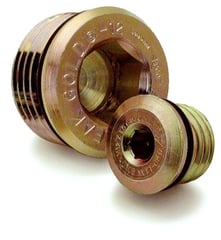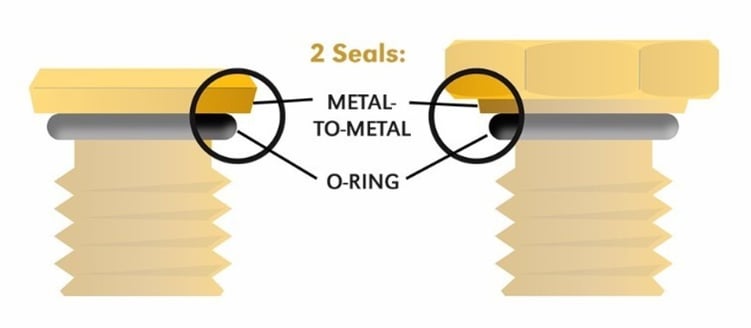Zero-Leak Plugs are used in high pressure and hydraulic applications that are prone to pressure spikes, and you will find them in all Genesis attachments except linkage tools.
 These plugs have an O-ring that is the initial sealing area but is not the primary sealing surface. They are made of a malleable material and have a tapered shoulder that compresses into a matching taper in the port. This metal-to-metal compression seal is what performs the primary sealing function, whereas traditional O-ring boss (ORB) fittings rely on a compressed O-ring for sealing.
These plugs have an O-ring that is the initial sealing area but is not the primary sealing surface. They are made of a malleable material and have a tapered shoulder that compresses into a matching taper in the port. This metal-to-metal compression seal is what performs the primary sealing function, whereas traditional O-ring boss (ORB) fittings rely on a compressed O-ring for sealing.

The Zero-Leak Plug is, therefore, a one-time use only plug that has very specific torque requirements to achieve the correct amount of swaging of the plug into the port.
When removing a plug, tap the face with a small hammer. This helps relieve the tension in the plug, allowing it to break free more easily. Not doing so on smaller plugs may strip out the plug hex bore.
When installing a plug, it's imperative that you use a torque wrench to tighten to the values specified below to help ensure leak-free performance.
|
A message from Tim
As always, if you have any service or maintenance questions, contact Tim at 218-349-5755, talseth@genesisattachments.com or Loren at 715-919-8316, llagesse@genesisattachments.com.
Note: the original article appeared in the monthly publication Tim's Tech Tips by Genesis Attachments www.genesisattachments.com
A message from Vice President of Sales and Marketing Andy Schwandt:
The pandemic has brought with it new challenges and supply chain issues across a variety of industries. Construction equipment is no exception. Click the video below to learn what you can do to mitigate these issues.
.png?width=233&height=125&name=RMS%20Logo%20-%20Hubspot%20(revised%202).png)